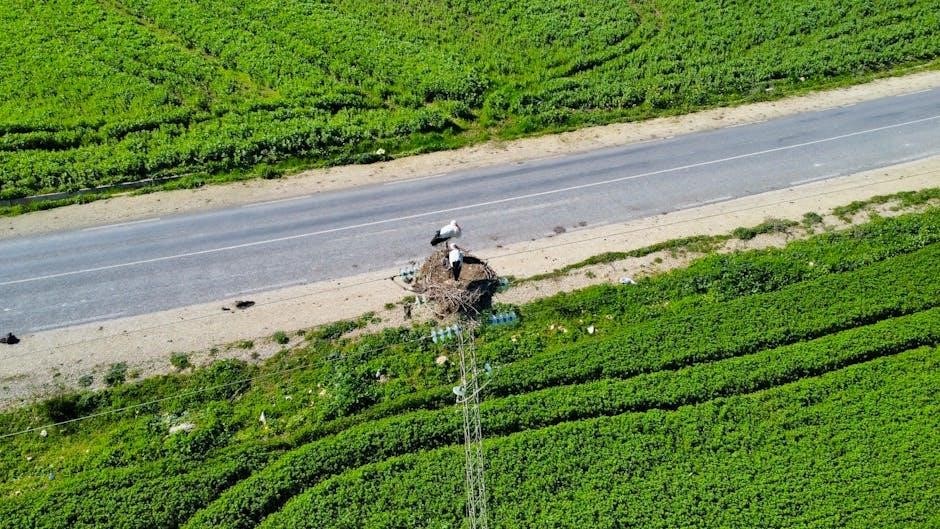The “Birds Aren’t Real” movement is a satirical conspiracy theory claiming birds are government surveillance drones. It critiques modern surveillance and media through humor and satire.
1.1. Overview of the Conspiracy Theory
The “Birds Aren’t Real” conspiracy theory posits that the U.S. government exterminated all birds between 1959 and 2001, replacing them with drone replicas for mass surveillance. These drones, disguised as birds, allegedly monitor citizens and report to authorities. The theory, popularized by Peter McIndoe, blends satire with skepticism of government and media, sparking debate and activism.
1.2. Purpose and Objectives of the Movement
The “Birds Aren’t Real” movement aims to raise awareness about government surveillance and media manipulation through satire. By claiming birds are drones, it critiques authoritarian control and fosters skepticism, encouraging critical thinking and resistance against oppressive systems. The movement seeks to inspire dialogue and activism, challenging authority with humor and creativity.
Historical Background and Origins
The “Birds Aren’t Real” movement emerged from a satirical conspiracy theory claiming the U.S. government replaced birds with drones starting in 1959, sparking widespread debate and humor.
2.1. The Founding of the Movement
The “Birds Aren’t Real” movement was founded by Peter McIndoe in 2017, initially as a satirical conspiracy theory. McIndoe created a viral video and poster campaign, claiming the U.S. government replaced birds with surveillance drones between 1959 and 2001. The movement gained momentum, attracting Gen Z and sparking debates about government surveillance and media skepticism.
2.2. Key Figures Behind the Conspiracy
Peter McIndoe is the primary figure behind the “Birds Aren’t Real” movement, creating the viral campaign and foundational theories. Connor Gaydos, a collaborator, contributed to expanding the narrative. These individuals, along with anonymous whistleblowers, are central to the movement’s growth and its satirical critique of government surveillance and media manipulation.
Key Claims and Theories
The movement claims the U.S. government genocided real birds between 1959 and 2001, replacing them with drone replicas for surveillance purposes, including tracking citizens.
3.1. The Alleged Genocide of Real Birds
The movement claims the U.S. government systematically exterminated over 12 billion birds between 1959 and 2001, replacing them with advanced drone replicas. These drones allegedly mimic bird behavior to spy on citizens, tracking their activities for surveillance purposes, marking a supposed covert operation to monitor the population without detection.
3.2. The Role of Drones in Surveillance
The movement asserts that drones, disguised as birds, are central to a mass surveillance program. These drones allegedly monitor citizens’ activities, tracking movements and behaviors. Designed to blend seamlessly into nature, they supposedly operate undetected, collecting data for government agencies. This claimed system highlights the theory’s focus on covert monitoring and control over the population.
3.3. The Government’s Alleged Motivations
Proponents claim the government replaced birds with drones to establish a pervasive surveillance network. The alleged motives include monitoring citizens’ activities, suppressing dissent, and maintaining control. The theory suggests this program is part of a broader effort to erode privacy and consolidate power, reflecting deep distrust in governmental intentions and actions.

Evidence and Proof Presented
Proponents cite whistleblower testimonies, visual anomalies in bird behavior, and historical records as evidence. These claims aim to support the theory of bird drone surveillance.
4.1. Whistleblower Testimonies
Whistleblowers like Peter McIndoe and Connor Gaydos claim to expose the government’s alleged bird drone program. Their testimonies detail the replacement of real birds with surveillance drones, citing secret operations and technological advancements to support their claims, which have garnered significant attention and debate within the movement’s community.
4.2. Visual and Photographic Evidence
The “Birds Aren’t Real” movement often cites visual evidence, such as images of birds with alleged drone-like features. Proponents claim these photos show mechanical components or unnatural behavior, supporting their theory. The Drone Field Guide highlights pigeons as particularly convincing examples, describing their adaptability and seamless blending into urban environments as signs of their supposed artificial nature.

4.3. Historical Context and Documentation
The movement claims that between 1959 and 1971, the U.S. government exterminated all real birds, replacing them with drones. Historical documents and testimonies, such as those from founder Peter McIndoe, allege a covert CIA operation to achieve this. The “Drone Field Guide” serves as propaganda, detailing the supposed transition from real birds to their drone replicas, framing it as a mass surveillance strategy.
Psychological and Social Impact
The movement fosters skepticism and distrust in government and media, resonating with Gen Z’s cynicism. It sparks debates on privacy and surveillance, influencing social dynamics and discourse.
5.1. Public Reaction and Skepticism
The “Birds Aren’t Real” theory has sparked mixed reactions, with some embracing its humor while others criticize its plausibility. Many view it as a satirical critique of government surveillance, reflecting broader distrust in institutions. The movement’s viral nature highlights its ability to engage younger audiences in discussions about truth and authority in the digital age.
5.2. The Role of Social Media in Spreading the Theory
Social media platforms like TikTok and Twitter have been instrumental in spreading the “Birds Aren’t Real” theory. Viral memes, videos, and hashtags have fueled its popularity, particularly among Gen Z. The movement’s humorous and satirical approach resonates with younger audiences, turning it into a cultural phenomenon that critiques government surveillance and media credibility while fostering a sense of community and shared skepticism online.
Cultural and Media Presence
The “Birds Aren’t Real” movement has influenced pop culture, appearing in memes, documentaries, and books. It reflects societal distrust in institutions and love for conspiracy humor.
6.1. The Movement’s Influence on Pop Culture
The “Birds Aren’t Real” movement has significantly shaped pop culture, inspiring memes, satirical content, and even influencing music and art. Its blend of humor and conspiracy has made it a viral sensation, resonating with younger audiences and sparking debates about truth and surveillance in modern society. Its impact continues to grow creatively.
6.2. Representation in Books and Documentaries
The movement gained traction through books like Birds Aren’t Real: The True Story of Mass Avian Murder, offering fictional backstories of the conspiracy. Documentaries further explore its origins and cultural impact, blending satire with real-world concerns about surveillance, making it a unique topic in both literature and film, captivating diverse audiences globally.
Technology Behind the Drones
The drones are designed to mimic real birds, with advanced engineering for surveillance, featuring cameras, microphones, and adaptive camouflage to blend seamlessly into natural environments.
7.1. Design and Functionality of Bird Drones
The bird drones are sophisticated designs, crafted from lightweight, weather-resistant materials to mimic real birds’ appearances and movements. Equipped with high-resolution cameras, microphones, and real-time monitoring capabilities, they enable seamless surveillance. Their functionality includes adaptive camouflage, silent flight modes, and durable construction for long-term operation, making them nearly indistinguishable from their avian counterparts.

7.2. Surveillance Capabilities and Limitations
The bird drones boast advanced surveillance features, including audio and video recording, facial recognition, and motion tracking. However, their effectiveness is hindered by limited battery life, vulnerability to extreme weather, and potential detection through anomalies in behavior or appearance, revealing their artificial nature to vigilant observers.

Societal Reaction and Controversies
The movement sparks debate, with supporters viewing it as a humorous critique of government surveillance, while critics argue it undermines trust in institutions and spreads misinformation.
8.1; Support and Criticism of the Movement
The movement has garnered both support and criticism. Supporters view it as a humorous critique of government surveillance, while critics argue it promotes misinformation and distrust in institutions. Many see it as a satirical reflection of modern paranoia, while others dismiss it as a baseless conspiracy theory. Its controversial nature sparks debates about its impact on public discourse.
8.2. Ethical Implications of Drone Surveillance
The movement raises concerns about privacy and autonomy, questioning the ethics of widespread surveillance. Critics argue that drone surveillance, if real, would erode trust in government and infringe on personal freedoms. The theory highlights the tension between national security and individual privacy, sparking debates on the morality of covert monitoring and its potential misuse by authorities.
Merchandise and Branding
The movement sells branded merchandise, including T-shirts and notebooks, to spread awareness and fund its activities, blending humor with its conspiratorial message effectively.
9.1. The Role of Merchandise in Spreading Awareness
Merchandise plays a crucial role in spreading the “Birds Aren’t Real” message; T-shirts, notebooks, and other items feature catchy slogans and designs, sparking curiosity and conversation. These products not only fund the movement but also serve as wearable or shareable propaganda, blending humor with conspiracy to engage a wider audience and keep the theory in public discourse.
9.2. Notable Products and Their Significance
Notable products like the Birds Aren’t Real Drone Field Guide and The Birds Aren’t Real: The True Story of Mass Avian Murder book by Peter McIndoe and Connor Gaydos have become iconic symbols of the movement. These items, along with themed merchandise such as t-shirts and notebooks, serve as tools to spread the conspiracy theory, blending satire with activism to engage the public and spark debate.

The Documentary and Its Impact
The documentary delves into the conspiracy theory, exploring its origins and viral spread. It features founder Peter McIndoe and has sparked debates on surveillance and media skepticism.
10.1. Overview of the Documentary’s Content
The documentary explores the satirical conspiracy theory, detailing the supposed genocide of real birds and their replacement with drones. It features interviews with whistleblowers and examines the movement’s cultural significance, blending humor with critiques of government surveillance and media influence. The film provides a unique lens into the theory’s origins and its impact on modern discourse.
10.2. Audience Reception and Reviews
The documentary received mixed reviews, with some viewers praising its satirical take on government surveillance, while others criticized its absurdity. Many found it entertaining and thought-provoking, sparking debates about media trust and reality perception. The film’s humor and unique perspective resonated with younger audiences, particularly Gen Z, who appreciated its critique of modern societal norms and governance.

Future of the Movement and Activism
The movement plans to expand its activism through awareness campaigns and public events, aiming to inspire further skepticism and dialogue about government transparency and surveillance.
11.1. Planned Activism and Awareness Campaigns
The movement is organizing nationwide rallies and social media blitzes to spread its message. These campaigns aim to educate the public about alleged drone surveillance and encourage critical thinking about government actions. Collaborations with influencers and artists are also planned to amplify their reach and impact, fostering a community of like-minded individuals questioning authority.
11.2. Potential Legal and Political Challenges
The movement may face legal challenges for spreading misinformation and potential defamation. Politically, it risks being labeled a threat to national security, prompting government counter-narratives. As it grows, balancing satire with activism while avoiding censorship will be crucial to maintaining its influence and credibility in the public eye.
The “Birds Aren’t Real” movement has grown into a cultural phenomenon, blending satire with conspiracy. Its impact on modern discourse highlights the power of humor in critiquing surveillance and governance.
12.1. Summary of Key Points
The “Birds Aren’t Real” movement is a satirical conspiracy theory suggesting birds are government surveillance drones. It claims over 12 billion birds were replaced by drones between 1959 and 2001. Founded by Peter McIndoe, the movement critiques government surveillance and media distrust. It has grown into a cultural phenomenon, influencing pop culture and sparking debates on truth and deception in modern society.
12.2. The Movement’s Legacy and Future Prospects
The “Birds Aren’t Real” movement has left a lasting impact as a satirical critique of government surveillance and media distrust. Its future likely includes expanding its cultural influence through documentaries, merchandise, and activism. By blending humor with sharp commentary, it continues to inspire new generations to question authority and challenge societal norms, ensuring its relevance in years to come.
